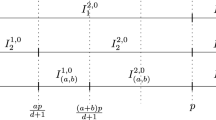Abstract
The frog model is a system of interacting random walks. Initially, there is one particle at each vertex of a connected graph. All particles are inactive at time zero, except for the one which is placed at the root of the graph, which is active. At each instant of time, each active particle may die with probability \(1-p\). Once an active particle survives, it jumps on one of its nearest vertices, chosen with uniform probability, performing a discrete time simple symmetric random walk (SRW). Up to the time it dies, it activates all inactive particles it hits along its way. From the moment they are activated, every such particle starts to walk, performing exactly the same dynamics, independent of everything else. In this paper, we consider the \(n-\)complete graph (a finite graph with each pair of vertices linked by an edge). We study the limit in n of the coverage ratio, that is, the proportion of visited vertices by some active particle up to the end of the process, after all active particles have died.
Similar content being viewed by others
Data Availability
Data sharing not applicable to this article as no datasets were generated or analysed during the current study.
References
Andersson, H., Britton, T.: Stochastic epidemic models and their statistical analysis. Springer, New York (2000)
Alves, O.S.M., Lebensztayn, E., Machado, F.P., Martinez, M.Z.: Random walks systems on complete graphs. Bull. Brazilian Math. Society (N.S.) 37(4), 571–580 (2006)
Alves, O.S.M., Machado, F.P., Popov, S.: Phase transition for the frog model. Electron. J. Probab. 7(16), 1–21 (2002)
Alves, O.S.M., Machado, F.P., Popov, S.: The shape theorem for the frog model. Ann. Appl. Probab. 12(2), 533–546 (2002)
Benjamini, I., Fontes, L.R., Hermon, J., Machado, F.P.: On an epidemic model on finite graphs. Ann. Appl. Probab. 30(1), 208–258 (2020)
Grimmett, G.R.: Probability on graphs: random processes on graphs and lattices, 2nd edn. Cambridge University Press, Cambridge (2018)
Grimmett, G.R., Stirzaker, D.R.: Probability random processes, 3rd edn. Oxford University Press, Oxford (2001)
Hermon, J.: Frogs on trees? Electron. J. Probab. 23(17), 1–40 (2018)
Hoffman, C., Johnson, T., Junge, M.: Recurrence and transience for the frog model on trees. Ann. Probab. 45(5), 2826–2854 (2017)
Hoffman, C., Johnson, T., Junge, M.: Cover time for the frog model on trees. Forum Math., Sigma 7(e41), 1–49 (2019)
Kosygina, E., Zerner, M.P.W.: A zero-one law for recurrence and transience of frog processes. Prob. Theory Related Fields 168(1–2), 317–346 (2017)
Lebensztayn, E., Estrada, M.A.: Laws of large numbers for the frog model on the complete graph. J. Math. Phys. 60, 123302 (2019)
Lebensztayn, E., Rodriguez, P.M.: A connection between a system of random walks and rumor transmission. Phys. A: Stat. Mech. Appl. 392(23), 5793–5800 (2013)
Mitzenmacher, M., Upfal, E.: Probability and computing: randomized algorithms and probabilistic analysis. Cambridge University Press, Cambridge (2005)
Popov, S.: Frogs in random environment. J. Stat. Phys. 102(1), 191–201 (2001)
Machado, F.P., Kurtz, T., Lebensztayn, E., Leichsenring, A.: Limit theorems for an epidemic model on the complete graph. Latin Am. J. Probab. Math. Stat. 4, 45–55 (2008)
Author information
Authors and Affiliations
Corresponding author
Ethics declarations
Conflict of interest
The authors have no conflicts to disclose.
Additional information
Communicated by Gregory Schehr.
Publisher's Note
Springer Nature remains neutral with regard to jurisdictional claims in published maps and institutional affiliations.
Research supported by Capes (88887.676435/2022-00), CNPq (303699/2018-3 and 132598/2020-5), FAPESP (17/10555-0).
Rights and permissions
Springer Nature or its licensor (e.g. a society or other partner) holds exclusive rights to this article under a publishing agreement with the author(s) or other rightsholder(s); author self-archiving of the accepted manuscript version of this article is solely governed by the terms of such publishing agreement and applicable law.
About this article
Cite this article
de Carvalho, G.O., Machado, F.P. The Coverage Ratio of the Frog Model on Complete Graphs. J Stat Phys 190, 147 (2023). https://doi.org/10.1007/s10955-023-03156-w
Received:
Accepted:
Published:
DOI: https://doi.org/10.1007/s10955-023-03156-w




